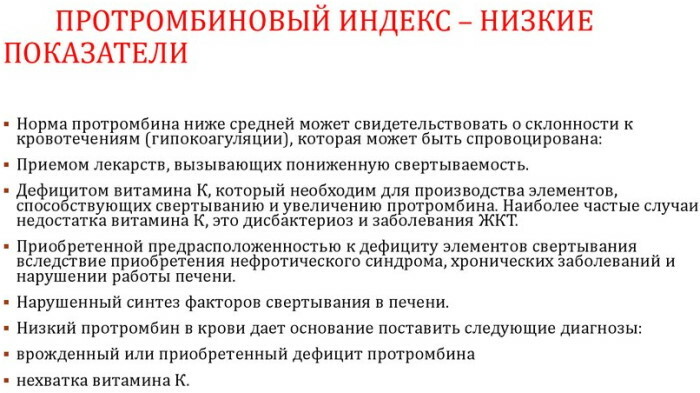Content
- What is the principle of the Schirmer test in ophthalmology based on?
- Indications for the test
- Contraindications
- Which doctor is doing the examination?
- Preparation for Schirmer's test
- Schirmer strip test
- Test methods
- Schirmer test I
- Schirmer II test
- Norms and deviations in the results
- Survey price
- Schirmer test video
The Schirmer test is a medical procedure often used in ophthalmology to measure the level of tear fluid in the eye. The research does not take much time and is affordable for the majority of the population.
What is the principle of the Schirmer test in ophthalmology based on?
Human lacrimal glands located at the corners of each eye. They are responsible for the production and transport of tears to the excretory ducts behind the upper eyelid. The tear fluid itself is necessary to moisturize the mucous membrane of the eye, preventing it from drying out. It also helps to reduce the risks of developing unpleasant symptoms caused by the negative impact of external factors.
Other functions of moisture:
- prevents deterioration of visual acuity;
- exhibits antibacterial and antiviral properties;
- removes toxic substances from the blood.
The principle of the procedure is based on the use of a special ophthalmic test strip, which is placed behind the lower eyelid. The strip itself is equipped with an indicator, on the basis of which the level of the tear fluid is determined.
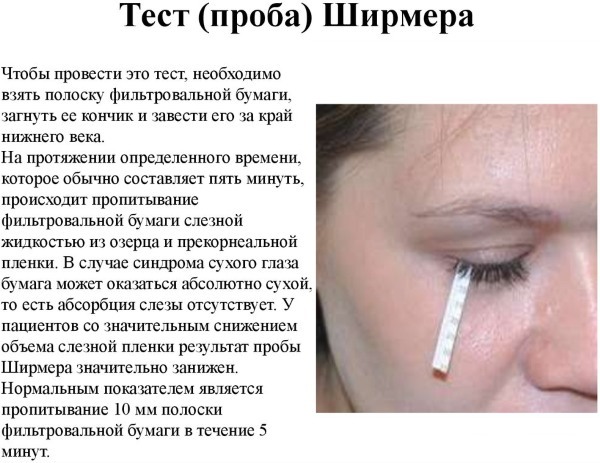
After the test is introduced into the eye cavity, the patient must close his eyes for 5 minutes. Then the strip is removed and the indicators are decoded. The procedures are non-invasive, however, in some cases, according to the doctor's indications, they can be performed using local anesthesia.
Indications for the test
Schirmer's test in ophthalmology is prescribed for patients who have signs of dry eye syndrome. Initially, the examination was prescribed for patients with signs of Sjogren's syndrome. In the future, the procedure began to be applied to all various pathologies that cause excessive dryness and insufficient production of tear fluid.
Additional indications:
- eye diseases, which are accompanied by a decrease in the production of tear fluid;
- malfunctions of the lacrimal canal;
- preventive examination of the elderly;
- consequences after previous operations (including laser vision correction), which contributed to excessive dryness of the eye membrane;
- diabetes;
- lack of vitamin A in the body;
- dehydration of the body;
- routine examination while taking certain medications - heart medications, contraceptives, antidepressants;
- complications and consequences after illnesses - lymphoma, arthrosis, leukemia.
It is also recommended to undergo diagnostics for those who spend a lot of time at the computer or TV, since eye fatigue can lead to insufficient production of tear fluid.
Symptoms for which you should also see a doctor:
- feeling of a foreign object in the eye;
- pain, burning, discomfort in the eyes;
- increased photosensitivity;
- decreased visual acuity, especially at night;
- signs of irritation - redness, fatigue, itching;
- the formation of mucous secretions in the area of the eyeball;
- increased lacrimation, blurred vision;
- discomfort and other discomfort caused by wearing contact lenses.
It is necessary to consult a specialist in cases when one of the signs bothers the patient for more than a day. You should not delay going to a medical institution, since pathology can lead to impaired visual functions.
Contraindications
Despite the relative safety of the procedure, it has some limitations that can lead to an exacerbation of the pathology.
Contraindications:
- ulcerative lesion of the cornea of the eye;
- the formation of erosion in the area of the stratum corneum;
- the presence of fistulas or fistulas, especially in cases of purulent discharge;
- deformation or perforation of the eyeball;
- colds;
- runny nose, otitis media;
- damage and injury to the eye area.
The test can be carried out only when the indicated signs are eliminated, since otherwise there are high risks of incorrect display of data or the development of complications and the consequences of existing violations.
Which doctor is doing the examination?
The Schirmer test is performed by an ophthalmologist, if the patient has indications for testing.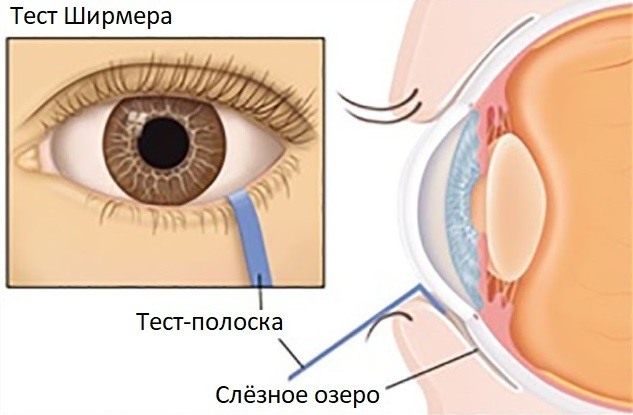
You can also go through the diagnosis yourself if the patient has all the necessary skills to carry it out. However, it is better to entrust this to a specialist, since it requires experience and knowledge of medicine to decrypt the data.
Preparation for Schirmer's test
Special preparatory measures are not required before diagnostics. If the patient has bacterial conjunctivitis, it is recommended that the disease be completely cured first, since the test strip may mistake the purulent contents for tears.
Immediately before the procedure, the patient should remove glasses or contact lenses, as this can complicate the study.
If necessary, or according to the testimony of a specialist, an anesthetic may be administered. It is recommended to wait a few minutes before the test until it takes effect.
Also, before the diagnosis, it is necessary to undergo additional examinations for the presence of contraindications, including restrictions on the use of the anesthetic.
A few days before the start of the test, you should stop using any ophthalmic drugs, especially those that increase or decrease the production of tear fluid.
Schirmer strip test
The stripes appear as thin filter paper and are the same standard size. The paper is 5 mm wide and 35 mm long. Each strip has a marked edge, from which it is necessary to retreat 5 mm and bend at an angle of 45 ° before use.
During the procedure, paper is placed under the lower eyelid. A qualified technician should perform these actions, since if the strip is used incorrectly, there is a possibility of damage to the eye shell.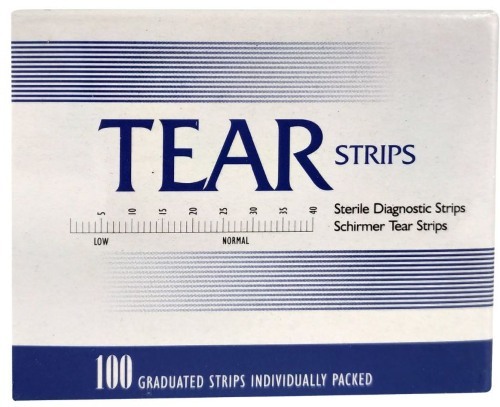
All tests are impregnated with a special liquid and equipped with a measurement indicator. When interacting with the tear fluid, the paper changes its color, by which the level of tear moisture is judged.
In the absence of any changes on the strip, this indicates that the patient has no tear fluid at all.
Test methods
Schirmer's test in ophthalmology is carried out in 2 ways - with closed or open eyes. During the study, 2 types of strips can be used - Schirmer's test No. 1 and Schirmer's test No. 2.
Schirmer test I
Schirmer's test strip No. 1 is introduced by a specialist after all the preparatory measures. To begin with, the doctor bends the strip at an angle of 450 and lays it with the bent side under the lower eyelid close to its lower part.
Then the patient needs to close his eyes and stay in this state for about 5 minutes. The study is carried out simultaneously on the left and right eyes, which will provide more reliable data.
After the specified time has elapsed, the specialist carefully removes the test strips and examines the obtained data on the indicator (degree of moisture).
When carrying out the procedure with open eyes, reflex blinking is allowed.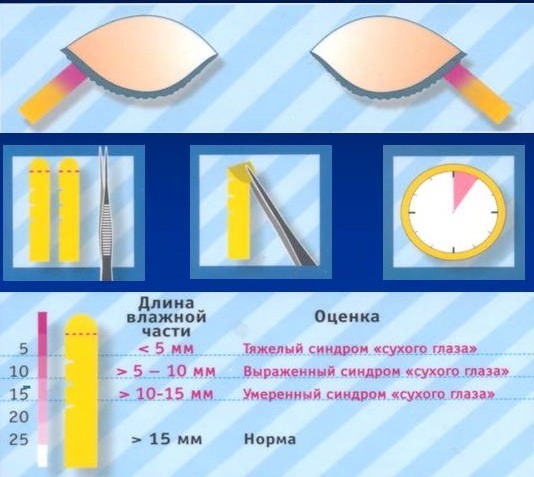
After all the manipulations, the specialist deciphers the data, where the level of the tear fluid will be indicated and further recommendations are given.
Schirmer II test
Schirmer's test No. 2 implies the use of an anesthetic drug. Before the procedure, the anesthesiologist puts (instills) an anesthetic into the lower eyelid area.
Before the onset of action of the drug, it is enough to withstand 2-3 minutes, after which they proceed directly to the study.
All further manipulations for the diagnosis are identical, as with the use of test strip No. 1 - the specialist puts the test paper and asks the patient to close his eyes (if necessary).
In most cases, the anesthetic has no effect on the success of the procedure. However, in some situations, the drug may interfere with the correct display of data. If you suspect such errors, it is recommended to undergo other methods of examination to determine the level of the tear fluid.
Also, the procedure can be carried out as a clarification of the diagnosis. For this, before using the test strips, the patient is given external irritation of the nasal passages. For this, the specialist uses ordinary cotton swabs.
Other stimulation methods can also be used, for example, inhalation of hydrogen sulfide (ammonia) vapors. This method is outdated and is used extremely rarely when it is impossible to use other stimulating actions.
With this method of research, the obtained indicators, as a rule, have a slightly overestimated value.
Norms and deviations in the results
Schirmer's test in ophthalmology is used regardless of the age and gender of the patient and is highly informative, and therefore is in demand among people of various social categories.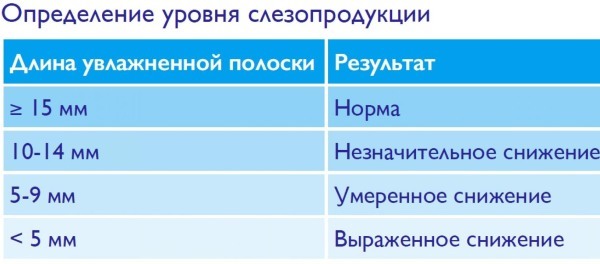
After completing the test, the specialist proceeds to decrypt the received data. During the diagnosis, the patient's age is taken into account, as well as the condition of the mucous membrane of the eye.
The younger the patient, the higher the moisture content of the mucous membrane. For patients under 25 years old, 15 mm of moisture in the test strip obtained in 5 minutes is considered normal. procedures.
In this case, the standard indicators (norm) are 10 mm or more moisture. For patients over 60 years of age, the norm is 10 mm below the wetting of the test paper.
Positive results are considered when the test strip is completely dry. In this case, the patient is diagnosed with dry eye syndrome, after which the appropriate therapy is prescribed.
Study result levels:
- 15 mm or more is the norm.
- 10-14 mm - soft.
- 5-9 mm - moderate.
- 4 mm or less - heavy.
It should be borne in mind that there may be a slight difference between the eyes. Discrepancies of no more than 25% are considered permissible norms. At higher rates, additional diagnostic methods may be prescribed.
As additional research methods, a slit lamp examination (biomicroscopy) can be carried out. In some cases, the Norn test is performed, which allows you to assess the condition and integrity of the tear film. The method of coloring the eye membrane using a contrast agent can also be used.
After the diagnosis is made, the specialist prescribes treatment, which in most cases means the use of various medications, the action of which is aimed at restoring the degree of hydration of the eye shell.
In more severe cases, surgery may be performed. This type of treatment is used for abnormalities in the structure of the tear ducts or injuries that contributed to the development of pathological changes in the production of tear moisture.
Survey price
The prices for examinations may vary depending on the region and area, as well as the clinic in which the testing will be carried out. The price includes an ophthalmologist's consultation (visual examination, recommendations), test strips and the procedure itself.
You can purchase the test paper yourself at any of the pharmacies located in the patient's place of residence. The prices for strips will also differ, depending on the region and the retail pharmacy chain.
| Region / region | Examination cost |
| Moscow, Moscow region | From 300 to 1100 rubles. |
| St. Petersburg | RUB 100-400 |
| Novgorod region | RUB 90-350 |
| Leningrad region | RUB 150-600 |
The Schirmer test is a completely safe and harmless procedure, and therefore, it can be used even in childhood. When carrying out it, there is no need to use complex equipment and use other special tools. To make an accurate diagnosis and establish the cause of the deviation, it is recommended to undergo a study in conjunction with other methods of eye diagnostics.
It is recommended to undergo the Schriemer test only in proven and certified ophthalmic centers, since the procedure requires high specialist skills and the ability to decipher the results samples.
Schirmer test video
Schirmer's test (test):

